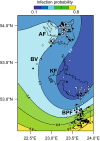Multispecies reservoir of Spirometra erinaceieuropaei (Cestoda: Diphyllobothridae) in carnivore communities in north-eastern Poland
- PMID: 33168087
- PMCID: PMC7654582
- DOI: 10.1186/s13071-020-04431-5
Multispecies reservoir of Spirometra erinaceieuropaei (Cestoda: Diphyllobothridae) in carnivore communities in north-eastern Poland
Abstract
Background: Spirometra erinaceieuropaei is a diphylobothriid tapeworm with a complex life-cycle including definitive, intermediate and paratenic (transport) hosts. Multiple routes of parasite transmission often make it impossible to determine what type of host a specific infected animal is considered to be. Spargana larvae cause sparganosis, a severe food- and water-borne disease mainly found in Asia. In Poland, Spirometra sp. was reported in large carnivores in Białowieża Primeval Forest for the first time in the 1940s and was recently confirmed as S. erinaceieuropaei in several mammals and snakes using molecular methods.
Methods: In total, 583 carcasses of 9 carnivore species were necropsied between 2013 and 2019 in north-eastern (NE) Poland. The larvae of S. erinaceieuropaei (spargana) were isolated from subcutaneous tissue, counted, and preserved for genetic analyses. We calculated the prevalence and intensity of infection. To assess spatial variation in S. erinaceieuropaei infection probability in NE Poland, we applied a generalized additive model (GAM) with binomial error distribution. To confirm the species affiliation of isolated larvae, we amplified a partial fragment of the 18S rRNA gene (240 bp in length).
Results: Spirometra larvae were found in the subcutaneous tissue of 172 animals of 7 species and confirmed genetically as S. erinaceieuropaei. The overall prevalence in all studied hosts was 29.5% with a mean infection intensity of 14.1 ± 33.8 larvae per individual. Native European badgers and invasive raccoon dogs were characterized by the highest prevalence. An analysis of parasite spread showed a spatially diversified probability of infection with the highest values occurring in the biodiversity hot spot, Białowieża Primeval Forest.
Conclusions: Our study revealed that various mammal species (both native and non-native) can serve as S. erinaceieuropaei reservoirs. The frequency and level of infection may differ between selected hosts and likely depend on host diversity and habitat structure in a given area. Further studies are needed to assess the distribution of the parasite throughout Europe and the environmental and biological factors influencing infection severity in wild mammals.
Keywords: European badger; Paratenic hosts; Plerocercoid larvae; Raccoon dog; Sparganosis; Zoonosis.
Conflict of interest statement
The authors declare that they have no competing interests.
Figures



Similar articles
-
The first case of genetically confirmed sparganosis (Spirometra erinaceieuropaei) in European reptiles.Parasitol Res. 2018 Nov;117(11):3659-3662. doi: 10.1007/s00436-018-6079-0. Epub 2018 Sep 15. Parasitol Res. 2018. PMID: 30220047
-
The first report of sparganosis (Spirometra sp.) in Eurasian badger (Meles meles).Parasitol Int. 2014 Apr;63(2):397-9. doi: 10.1016/j.parint.2013.12.011. Epub 2014 Jan 5. Parasitol Int. 2014. PMID: 24398022
-
Prevalence and molecular characterization of Spirometra erinaceieuropaei spargana in snakes in Hunan Province, China.J Helminthol. 2020 Feb 27;94:e131. doi: 10.1017/S0022149X20000139. J Helminthol. 2020. PMID: 32103785
-
Sparganosis (Spirometra) in Europe in the Molecular Era.Clin Infect Dis. 2021 Mar 1;72(5):882-890. doi: 10.1093/cid/ciaa1036. Clin Infect Dis. 2021. PMID: 32702118 Review.
-
Prevalence of Spirometra mansoni in dogs, cats, and frogs and its medical relevance in Guangzhou, China.Int J Infect Dis. 2016 Dec;53:41-45. doi: 10.1016/j.ijid.2016.10.013. Epub 2016 Oct 21. Int J Infect Dis. 2016. PMID: 27777093 Review.
Cited by
-
Genetic interrelationships of Spirometra erinaceieuropaei (Cestoda: Diphyllobothriidea), the causative agent of sparganosis in Europe.Parasite. 2022;29:8. doi: 10.1051/parasite/2022009. Epub 2022 Feb 11. Parasite. 2022. PMID: 35148496 Free PMC article.
-
Unique genetic structure of the human tapeworm Dibothriocephalus latus from the Alpine lakes region - a successful adaptation?Parasitology. 2022 Jul;149(8):1106-1118. doi: 10.1017/S0031182022000634. Epub 2022 May 16. Parasitology. 2022. PMID: 35570686 Free PMC article.
-
Digestive tract nematode infections in non-native invasive American mink with the first molecular identification of Molineus patens.Int J Parasitol Parasites Wildl. 2020 Dec 29;14:48-52. doi: 10.1016/j.ijppaw.2020.12.006. eCollection 2021 Apr. Int J Parasitol Parasites Wildl. 2020. PMID: 33437614 Free PMC article.
-
Metazoan parasite fauna of the American mink (Neogale vison) in comparison with the closely related European mink (Mustela lutreola) in Europe.Parasitol Res. 2025 Aug 18;124(8):92. doi: 10.1007/s00436-025-08543-8. Parasitol Res. 2025. PMID: 40824309 Free PMC article.
References
-
- Sorci G, Garnier S. Evolutionary ecology: evolution of parasitism. In: Fath BD, editor. Encyclopedia of ecology. 2. Amsterdam: Elsevier; 2019. pp. 304–309.
-
- Wells K, Gibson DI, Clark NJ. Global patterns in helminth host specificity: phylogenetic and functional diversity of regional host species pools matter. Ecography. 2019;42:416–427. doi: 10.1111/ecog.03886. - DOI
-
- Hoberg EP, Brooks DR. A macroevolutionary mosaic: episodic host-switching, geographical colonization and diversification in complex host-parasite systems. J Biogeogr. 2008;35:1533–1550. doi: 10.1111/j.1365-2699.2008.01951.x. - DOI
-
- Agosta SJ, Janz N, Brooks DR. How specialists can be generalists: resolving the ‘parasite paradox’ and implications for emerging infectious disease. Zoologia. 2010;27:151–162. doi: 10.1590/S1984-46702010000200001. - DOI
-
- Bush AO, Fernandez JC, Esch GW, Seed JR. Parasitism. The diversity and ecology of animal parasites. 1. Cambridge: Cambridge University Press; 2001.
MeSH terms
Substances
Grants and funding
LinkOut - more resources
Full Text Sources
Miscellaneous

